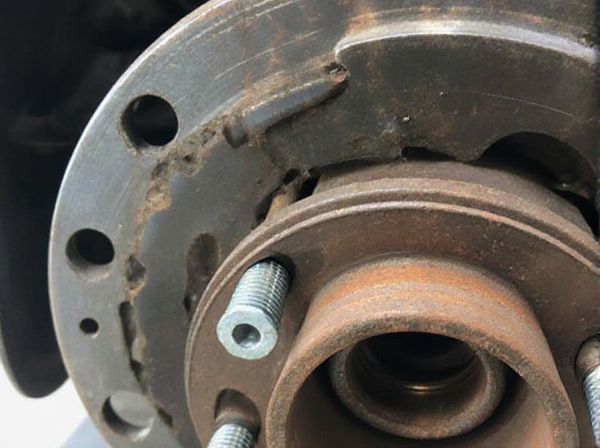
Photo illustration: Bolt-on Flange vs Welded Flange
Bolt-on flanges provide ease of installation and removal due to their bolted connection, making them ideal for maintenance and repairs in piping systems. Welded flanges offer superior strength and leak resistance by creating a permanent connection through welding, ensuring durability in high-pressure and high-temperature environments. Your choice between the two depends on the specific application requirements, balancing convenience with performance.
Table of Comparison
| Feature | Bolt-on Flange | Welded Flange |
|---|---|---|
| Installation | Easy, bolts on without welding | Requires professional welding |
| Strength | Moderate, depends on bolt torque | High, permanent strong weld |
| Maintenance | Simple, bolts can be removed | Complex, weld removal needed |
| Cost | Lower initial cost | Higher cost due to welding |
| Flexibility | Allows easy driveline adjustments | Permanent, no quick changes |
| Durability | Good under normal conditions | Excellent under high stress |
Introduction to Flange Connections
Flange connections are essential components in piping systems, providing a secure method to join pipes, valves, pumps, and other equipment. Bolt-on flanges allow easy assembly and disassembly through bolted fasteners, making maintenance and inspection more convenient. Welded flanges offer a permanent, leak-proof connection by fusion welding the flange directly to the pipe, ensuring high strength and durability in high-pressure applications.
What is a Bolt-on Flange?
A bolt-on flange is a mechanical component used to connect pipes and components securely, featuring a removable design that allows easy installation and maintenance. It is attached to the pipe using bolts, making it suitable for applications requiring frequent disassembly or inspection. Unlike welded flanges that require permanent attachment through welding, bolt-on flanges enhance flexibility and reduce downtime in pipeline systems.
What is a Welded Flange?
A welded flange is a type of pipe flange that is permanently attached to the pipe through welding, ensuring a secure and leak-proof connection ideal for high-pressure and high-temperature applications. This flange type offers excellent strength and durability by creating a solid joint between the flange and the pipe, commonly used in industrial piping systems such as oil, gas, and chemical plants. Compared to bolt-on flanges, welded flanges eliminate the risk of flange movement and provide better resistance to vibration and stress.
Key Differences Between Bolt-on and Welded Flanges
Bolt-on flanges are attached using bolts to pipe ends or equipment, offering easy installation and removal for maintenance or replacement, while welded flanges are permanently fused to pipes through welding, providing a stronger, leak-proof connection ideal for high-pressure systems. Bolt-on flanges typically allow for flexible alignment and reduced downtime, whereas welded flanges ensure enhanced structural integrity and resistance to mechanical stress. The choice between bolt-on and welded flanges hinges on factors such as required maintenance frequency, pressure ratings, and the need for a permanent versus detachable joint.
Strength and Durability Comparison
Bolt-on flanges provide moderate strength and durability suitable for applications requiring frequent disassembly, as their mechanical fastening allows for easy maintenance but may loosen under high stress or vibration. Welded flanges offer superior strength and long-term durability due to the fusion weld creating a continuous metal connection, making them ideal for high-pressure and high-temperature environments. The inherent rigidity of welded flanges reduces leakage risk and enhances structural integrity compared to the removable, but less robust, bolt-on flange design.
Installation Process and Requirements
Bolt-on flanges provide a simpler installation process, requiring only bolt tightening without the need for specialized welding equipment or skilled welders, making them ideal for quick assembly and maintenance. Welded flanges demand precise welding techniques and skilled labor to ensure a strong, leak-proof joint, often involving pre-welding preparation, post-welding inspection, and possible heat treatment to maintain pipe integrity. The choice between bolt-on and welded flanges depends heavily on project demands for time efficiency, structural strength, and long-term durability.
Maintenance and Inspectability
Bolt-on flanges offer easier maintenance and inspectability due to their removable design, allowing quick disassembly without cutting or welding. Welded flanges provide a strong, leak-proof connection but require more extensive effort for inspection and maintenance, often necessitating welding equipment and downtime for repairs. The choice impacts operational efficiency, with bolt-on flanges enabling faster routine checks and flange replacements.
Cost Implications and Budget Considerations
Bolt-on flanges typically offer lower initial installation costs due to simpler assembly and reduced labor time compared to welded flanges, which require skilled welding and inspection processes. In budget-sensitive projects, bolt-on flanges minimize downtime and labor expenses, making them favorable for maintenance and replacement scenarios. While welded flanges provide superior leak resistance and strength, their higher upfront costs and longer installation durations can impact overall project budgets significantly.
Typical Applications and Industry Use Cases
Bolt-on flanges are commonly used in low-pressure piping systems within water treatment plants and HVAC applications due to their ease of installation and maintenance. Welded flanges find typical applications in high-pressure environments such as oil and gas pipelines, petrochemical refineries, and power plants where secure, leak-proof connections are critical. Industries requiring frequent disassembly or maintenance, like chemical processing, often prefer bolt-on flanges, while welded flanges dominate sectors demanding robust, permanent joints.
Choosing the Right Flange Type for Your Project
Choosing between bolt-on flanges and welded flanges depends on project requirements such as pressure ratings, ease of installation, and maintenance needs. Bolt-on flanges offer quick assembly and disassembly, making them ideal for systems requiring frequent inspection or repair, while welded flanges provide superior strength and leak resistance, suitable for high-pressure or permanent applications. Project engineers must assess factors like pipe material compatibility, operating conditions, and long-term service expectations to select the most efficient flange type.
 caratoz.com
caratoz.com